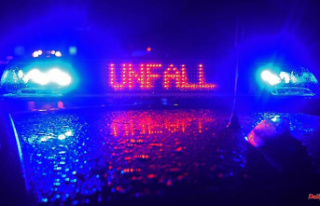In terms of number and area, 2022 is already one of the exceptional years for forest fires. Above all, the major fire in Gohrischheide at the end of July has an impact - most of the fires have no natural cause.
Pirna (dpa/sn) - In Saxony, far more hectares of forest have burned in recent weeks than in the years since 2008. With the fires at the end of June in Gohrischheide and the current fire in Saxon Switzerland, the affected area adds up around 850 hectares. According to the state company Sachsenforst, 147 smaller fires have been reported so far, affecting a total of more than 100 hectares. In addition, there are around 545 hectares in the Gohrischheide and around 150 hectares in the rocky world of the Elbe Sandstone Mountains.
In terms of area, the similarly dry year 2018 was topped, for which the statistics show a total of 240 hectares - the previous maximum. "Similar dimensions existed in the 1990s," said Sachsenforst spokesman Renke Coordes. The last comparable event dates from 1992, when more than 1,000 hectares of forest near Weißwasser (Görlitz district) burned for three weeks.
Around 60 percent of forest fires are caused by negligence: smoking, campfires or barbecues in the forest or cars with heated catalytic converters parked on dry vegetation. "The second most common cause is intentional arson, averaging 15 percent," said Coordes. Their share fluctuates between 5 and 25 percent per year. In about a third, it is not clear how the fire started. Only about four percent have natural causes.
The clarification of arson is rather improbable because of the location of the traces if there are no witnesses. "Fire almost destroys the traces," said Tom Bernhardt from the State Criminal Police Office (LKA) in Saxony. In 2021, suspects could not even be identified in 20 of the 100 cases, this year there are a good 20.
The northern parts of the districts of Nordsachsen, Meißen, Bautzen and Görlitz are particularly at risk because of the drought. According to Coordes, it is warmer there on average and it rains less. "The sandy soils cannot hold water for long, and the dried-up needles of the many pines catch fire easily." In summer, these regions are automatically monitored with 17 cameras, and when it is very dry, the fire watchtowers are manually manned to give an early alarm if there is smoke.
Most wildfires are small and can be extinguished quickly, Coordes said. Areas that are difficult to access such as the Saxon Switzerland National Park in the Elbe Sandstone Mountains or areas contaminated with ammunition such as the Gohrischheide are a challenge. "There are many of them in Saxony." In addition to the former military training areas, there are still duds from the Second World War.












